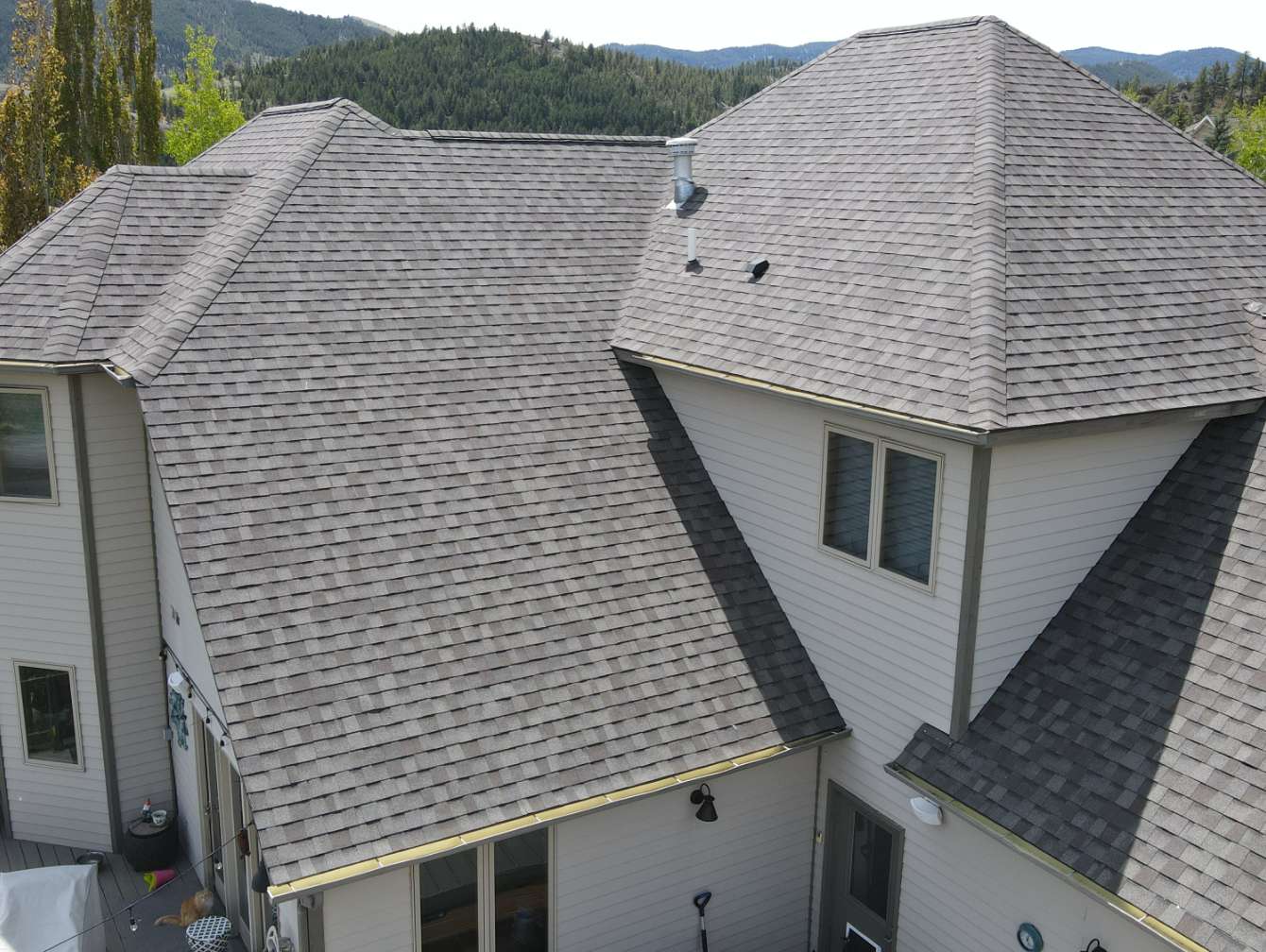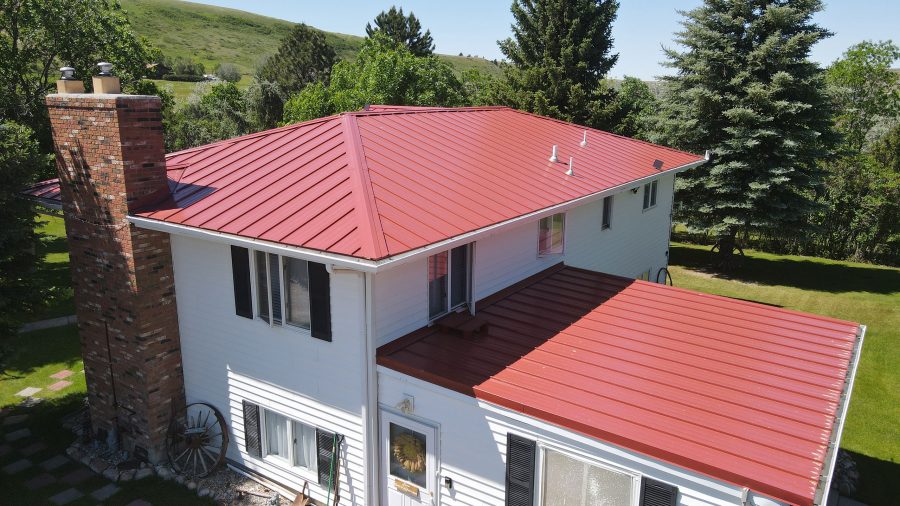Choosing a roof pitch is a vital part of the construction process. Each state has building codes to determine the minimum slope – this depends on the choice of materials, the roof’s purpose, and local climatic conditions.
When you’re planning to install a new roof, your local roofer will advise you on the optimal pitch for your needs. This is important whether you opt for a gorgeous wood shingle roof, a durable metal roof, or you need cheap-and-easy modified bitumen roofing for a commercial unit. Expert installation and adherence to state building codes are mandatory.
Today we’ll cover the minimum pitch for all types of roofing in Helena, Montana. We’ll explain the technical jargon, how to choose the best roof pitch and the advantages of working with a roofer who can advise you on the optimal materials for your needs.
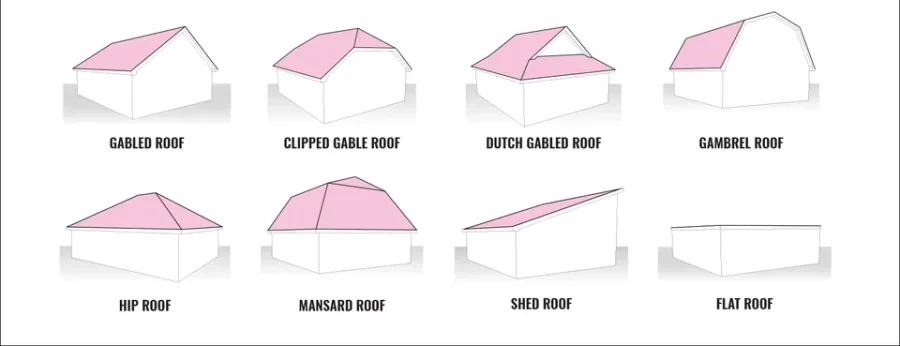
Why Does Roof Pitch Matter?
The primary purposes of a roof slope are to let water drain efficiently and protect your home against the wind. This is why there are no “flat” roofs. Although we often talk about flat roofs in the industry, this refers to a structure with a very low slope. If it was at a 1:1 vertical/horizontal pitch, water would sit on the surface and eventually lead to a cave-in.
Likewise, most slopes aren’t extremely steep because they would struggle to hold up against strong winds. The slope is designed to be aerodynamic like the front of a car; the wind is directed up and over it without pulling against the surface. If a surface is almost vertical, the wind will slam into it at full force and could eventually tear it off.
Another consideration when choosing the slope is the extra internal space it offers. Steeper options can provide a spacious loft, whereas low-slope roofs might offer limited or no loft space. This makes steeper slopes more attractive for residential properties.
State codes allow for a wide variety of designs, so the good news is that you have many safe, durable options to choose from. Having a striking design can make your home stand out from your neighbors – the important thing is that you’ve worked with an expert roofer to ensure that it’s installed safely and using the best materials. Failure to comply with state regulations can lead to your insurance being invalidated if there’s an accident.
Slope Types – Key Differences
If you’re considering replacing your existing roof, a major question is – do you want to change the roof’s slope or keep it the same? Having a new design installed can be refreshing and help make the property feel more like home. It might also give you greater loft space or even protect your home better if the old system was designed poorly for your area.
Below we offer a general guide to the various slope types available in Montana, what they’re best for, and what products you might choose for each style.
Steep Slope Roof
A steep slope is defined as having a minimum slope above 4:12. This means that for every 4 units of vertical span, the roof covers 12 units of horizontal span. The most common roof pitch for residential properties tends to be around 6:12 by this calculation.
Applications
Steeper roofs are popular because they tend to drain more effectively. Water runs off the eaves of steeper gradients easily and can be collected and disposed of by well-installed gutters with minimal risk of overflow. It’s an ideal formula for everyday use.
A common question is “is a 3/12 roof pitch good for snow?” Steeper pitches are preferred because we receive high volumes of snow. When snowfall reaches a critical mass, it will often slide off higher pitches, thus reducing the risk of the structure being overwhelmed by heavy snowfall.
Roofing in Montana typically requires that it can hold snow loads of up to 30lbs/sq ft. This is calculated as part of the “live load”, i.e. not including the weight of the construction materials. A higher live load makes it more difficult for a contractor to conduct repairs, as they may need to put weight on the surface to reach a damaged area.
Steeper slopes make it easier to dispose of snow. This doesn’t just mitigate the risk of roof collapse but makes it easier to have emergency maintenance work done. As heavy snowfall is an ever-present risk across Montana, steeper slopes tend to be preferred by homeowners as well as businesses.
Another major advantage of steep slopes is that the high rise gives you extra attic space. This can be used for storage or even as an extra bedroom – steeper structures are often preferred by families for this reason.
Popular Materials
Many types of material are used for steeper roofs. Asphalt shingles are an enduringly popular choice because they’re cheap to install. Shingles from top manufacturers also tend to be long-lasting compared to run-of-the-mill options, which is why the best Helena roofing contractors advise investing in high-quality shingles when you arrange a replacement.
Wood shingles are another popular choice – these give your home a beautiful, rustic look. Wood is an acceptable material for steeper models because the high gradient allows for better drainage. While wood shingles are treated to make them more waterproof, they’ll never have the same durability as metal, clay, or asphalt.
Metal roofs often have a steep slope, especially when a metal shingle system is being used. Metal is an increasingly popular choice because it can last for an incredibly long time and requires little maintenance. It can also deal with greater live loads than other products, so in the unlikely event that it needs maintenance, it’s easy for contractors to walk where they need to go.
Products used for steep gradients tend to be long-lasting and more expensive – you’ll rarely see single-ply systems attached to steep slopes. These systems are typically preferred by homeowners who are investing in the long-term health and beauty of their property.
Advantages
• Drains very easily
• Snow falls away
• Good for high winds
• Increased loft space
• Wide variety of high-quality products
• Gorgeous to look at
Disadvantages
• Usually more expensive
Low-Sloped Roof
A low roof slope has a vertical/horizontal roof pitch of 3:12 or less. These are used for residential and commercial applications. Building codes note some key differences in construction between systems greater than 2 units vertical to 12 units horizontal and those that are even flatter than this.
Applications
A gentle slope allows wind to pass easily over the top of a building. These models are often preferred in built-up areas for this reason, especially if neighboring buildings also use a low pitch. If your property is the only structure with a steep gradient nearby, the wind might hit you harder than your neighbors!
Models measuring 2 inches vertical to 12 inches horizontal or more require a double layer of underlayment. Systems that measure 4 inches vertical to 12 inches horizontal or more only require a single layer – this is because a gentler slope doesn’t drain as efficiently, so the extra protection is needed beneath the shingle layer.
So is a 1/12 roof pitch ok? An advantage of these systems is that installation is cheaper and easier than a steeper roof slope. They don’t rise as dramatically, so they’re easy to secure.
Another benefit is that a gentler slope can save on energy costs. The increased attic space you get with a slope of a minimum of 4 inches to 12 inches vertical/horizontal means that there’s more space for hot air to rise. You’re spending more heating your property than with a lower slope.
Popular Materials
Metal sheets that use applied lap sealant are a popular construction material for low-slope options. They’re durable and waterproof compared to other products and a metal panel is very easy to affix on a gradient of 3:12 inches or less. Many commercial metal roofs meet this definition.
Products like mineral-surfaced roll roofing and single-ply systems are popular for commercial applications. These are easy to install, very cheap, and durable if you buy them through a reputable manufacturer.
Asphalt shingles can be installed if the gradient is a minimum of 2:12 inches or more. If the slope is measured as less than 1 unit vertical to 6 units horizontal, asphalt shingles are prohibited in Montana. This minimum slope exists because of weight and drainage concerns.
Many products such as slate, clay tile, and metal shingles aren’t usable for most low-slope systems. A higher minimum slope allows water to drain freely – without this minimum, water can run into your property under gaps in the shingles. Wood shingles are also unavailable for low-slope roofs because they’re more vulnerable to leaks and saturation.
Advantages
• Cheaper to install
• Products are often affordable
• Energy-efficient
• Great for commercial properties
Disadvantages
• Fewer options
• More vulnerable to leaks
• Less attic space
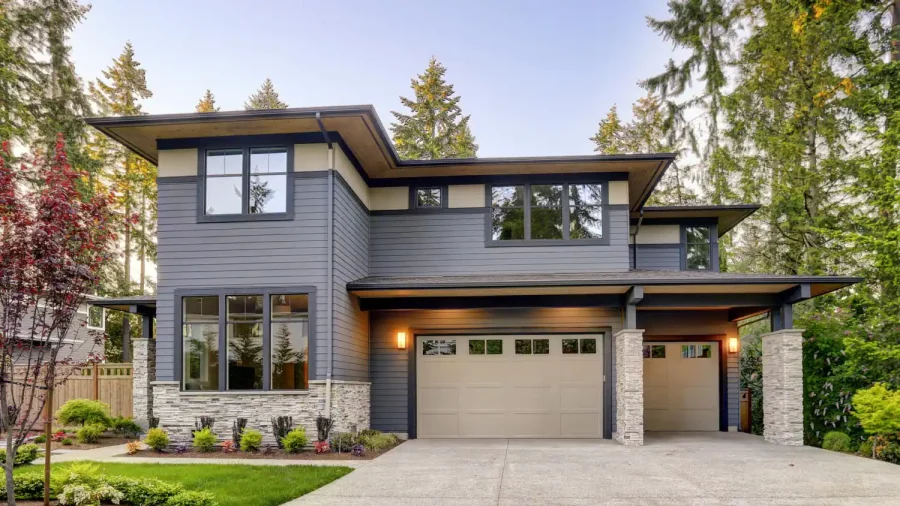
Flat Roof
There’s no such thing (or shouldn’t be!) as a flat roof. The minimum slope requirements for virtually all roofs in Montana are one-quarter unit vertical to 12 units horizontal (except for coal-tar built-up roofs, which can have a slope line of 1/8:12.).
Applications
When contractors refer to flat roofs, they typically mean a roof that meets the minimum slope requirements for Montana – and no more. While low-slope models might be up to three units vertical to twelve units horizontal, “flat” means “as close to flat as possible”.
They’re very popular for commercial applications, as they’re cheap and easy to install. The price per square foot is much lower than metal panels, which are another alternative for roofs measuring 1/4 inches horizontal to 12 inches vertical.
If you want a flat roof to last for longer, metal might be a better option. However, for short-term commercial operations, single-ply and roll roofing tends to be preferable as long-term durability isn’t such an issue.
Popular Materials
Single-ply membranes are among the most popular products. Sprayed and liquid-applied products are also used for some industrial systems: installation of all these products is quick and easy.
It’s still important to consider the manufacturer with cheap flat roofs. Your roofer will be able to advise you on the best manufacturer and product for your needs.
Advantages
• Products are cheap
• Great for industrial units
• Can be installed quickly
Disadvantages
• Can’t handle heavy loads
• Less appropriate for residential properties except for outhouses/extensions
• More vulnerable to hail and storm damage
Considerations When Determining Roof Slope
Here’s what to think about when choosing the roof pitch for your property.
Material Type
We’ve provided a full breakdown of roof slope by product below. As a general rule, a steeper roof pitch gives you a wider choice of long-lasting, attractive options. Gentler slopes are suitable for cheap, quick-to-install products.
Underlayment
In Montana, a roof pitch of 2:12 – 4:12 requires a double layer of underlayment to offer extra protection against leaks. This will cost slightly more to install.
Wind Resistance
The weather in Helena, MT means you need good protection against high winds. This means that super-steep slopes aren’t always a good option.
Ice Barriers
If your property is susceptible to ice forming under the eaves, an ice barrier may need to be installed. This prevents water from getting into cracks and expanding, which can damage your roof.
Application
Some products are more expensive to install than others. Certain types of shingle or metal roofs might also require a specialist contractor to install – contact your local roofing expert to learn about their range of products.
Flashing
Flashing helps prevent water build-up in vulnerable areas. The type of flashing required depends on the building’s style, e.g. whether it has gables or siding. Flashing keeps water away from the siding and directs it into the gutter.
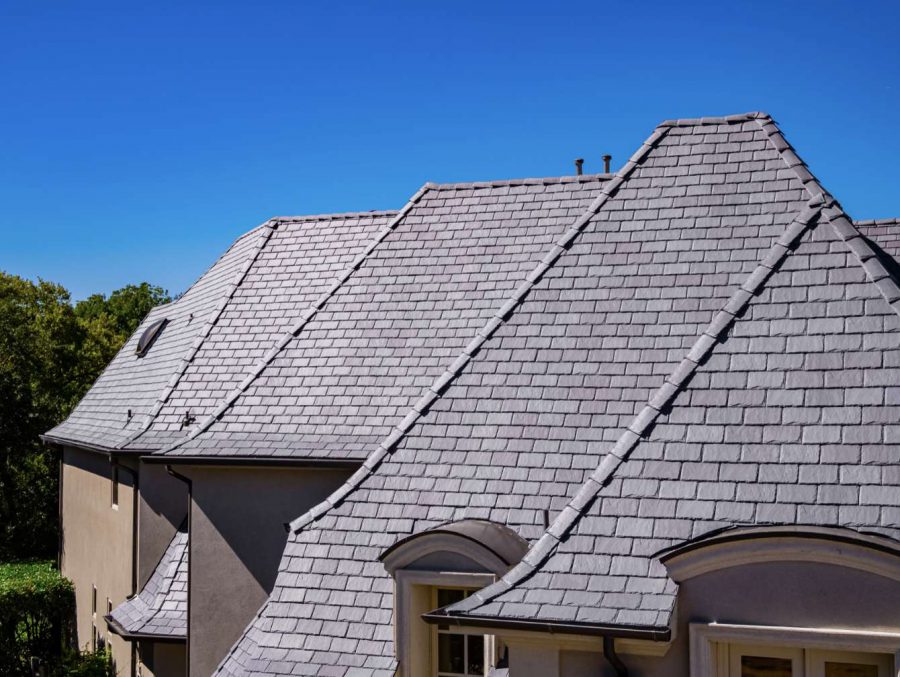
What is the Minimum Recommended Pitch for a Roof? By Material
Here’s a guide to the minimum slope for different products.
Asphalt Shingles
A good all-weather solution for residential properties, the minimum pitch is 2:12 for an asphalt shingle option. If the rise is less than 4:12, a double layer of underlayment must be used. Shingle options use a corrosion-resistant fastener.
Clay & Concrete Tile
The minimum pitch for clay or concrete tile is 2.5 inches horizontal by 12 vertical. It follows the same double-underlayment rule as asphalt for pitches under 4:12. Tile is often more expensive, but long-lasting and beautiful. It must be applied with a corrosion-resistant fastener.
Metal Roof Shingles
The lowest roof slope for a metal roof using shingles is measured at 3:12. A metal roof is a great choice as it’s long-lived and allows contractors to walk easily where they need to conduct repairs.
Mineral-Surfaced Roll Roofing
The minimum roof pitch for these applications is one foot horizontal to twelve feet vertical. Your roofer should take extra care around the edge, as this portion of the structure is vulnerable to fraying if it’s not properly installed.
Slate Shingles
Slate can be expensive but it’s long-lasting and turns the head – it’s a gorgeous option. It’s very heavy, and its minimum roof slope is 4:12.
Wood Shingles
Wood shingles are beautiful but can be more vulnerable to wet weather. The minimum roof slope is 3:12 to prevent waterlogging.
Wood Shakes
Wood shakes are another attractive, rustic option. They require a strong fastener to hold them in place. The lowest slope is measured at 3:12 for wood shakes.
Metal Roof Panels
A metal roof using a lapped, non-soldered system is 3:12 without the use of lap sealants. If a sealant is used, the metal roof slope’s course should measure at least 0.5:12.
Other Types
The following products all measure 0.25:12 as their minimum slope. They’re popular choices for industrial building roof installation and can be installed without the need for a fastener (which is mandatory for shingle or tile roof installation and takes extra time).
• Built-up roof
• Modified bitumen
• Standing seam metal roof panels
• Thermoset single-ply roofing
• Sprayed polyurethane foam roofing
• Thermoplastic single-ply roofing
• Liquid-applied roofing
How to Choose Your Roof Slope
Now that we’ve covered the roof slope requirements for different systems, it’s time to choose your new roof!
Purpose
A key factor when choosing the best roof slope is what it’s for. Residential customers typically prefer higher slopes, as they offer longer-lasting protection and make your home more visible. Business and industrial customers might prefer a cheaper option for short-term applications.
Installation
The installation cost for one foot of slate is far more than that of traditional asphalt shingles. However, it might last much longer. Installation cost should be measured against longevity.
Maintenance
Across the course of your roof’s life, it’ll need repairs from an expert contractor. Metal is typically much lower maintenance than other products, while wood looks beautiful but often requires more maintenance.
Location
What is the minimum roof pitch for snow? There’s no hard-and-fast rule, but a ratio of 1:12 minimum is generally recommended. Some parts of Montana receive much more snow – customers in these areas might want a higher roof pitch. Likewise, if your location is rural, a high slope with gables might offer better protection against the wind than in urban areas.
Cost of Materials
Metal roofs are expensive but long-lasting. Asphalt shingles from top manufacturers are much more affordable and can still stand the test of time. Speak to your local roofer about how cost-effective different roofing options are.
Aesthetics
Roofs with features like durability and snow resistance can be beautiful, but many people love wood shakes or shingles because they turn the head. You also need to consider whether your preferred material is appropriate for your roof slope – a low roof pitch limits your range of options.
Roof Pitch in Montana: Final Thoughts
Whether you choose metal, wood, slate, or a roll-on roofing type for your building, the most important thing is to hire an expert contractor for installation. The team at America’s Choice Roofing can explain more about the best roof types and the ideal roof slope – contact us today.
